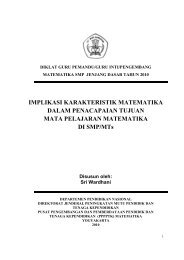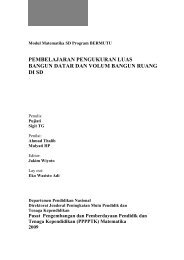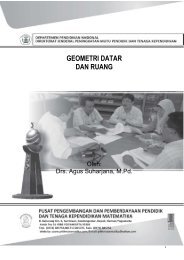25 Biggest Mistakes Teachers Make and How to Avoid Them
25 Biggest Mistakes Teachers Make and How to Avoid Them
25 Biggest Mistakes Teachers Make and How to Avoid Them
Create successful ePaper yourself
Turn your PDF publications into a flip-book with our unique Google optimized e-Paper software.
Preface <strong>to</strong> the<br />
Second Edition<br />
<br />
The first edition of <strong>25</strong> <strong>Biggest</strong> <strong>Mistakes</strong> <strong>Teachers</strong> <strong>Make</strong> <strong>and</strong> <strong>How</strong> <strong>to</strong> <strong>Avoid</strong> <strong>Them</strong><br />
has been a bestseller for a number of years <strong>and</strong> has been translated in<strong>to</strong><br />
three languages, Thai, Chinese, <strong>and</strong> Slovenian. It has been reviewed in India,<br />
used in a school of midwifery in Irel<strong>and</strong> <strong>and</strong> in numerous other contexts in<br />
many states in the United States <strong>and</strong> several countries such as Irel<strong>and</strong>,<br />
Romania, India, France, China, United Kingdom, Japan, <strong>and</strong> others.<br />
When I wrote the book, I thought it had an important message that teachers<br />
could avoid making mistakes by being aware of the mistakes of others.<br />
<strong>How</strong>ever, I was surprised by the global appeal of the book. As I reflected on<br />
why the global appeal, I recalled a picture I received. Rachel Livsey, my edi<strong>to</strong>r<br />
at the time, sent the picture <strong>and</strong> a message that said, “I thought you might<br />
get a kick out of this.” My first reaction was why? The picture looked like it<br />
was taken in San An<strong>to</strong>nio, Texas. The children were lined up in straight rows<br />
<strong>and</strong> a male teacher with a stick was directing them <strong>to</strong> get on a bus. I unders<strong>to</strong>od<br />
why when I saw that it was a picture in a newspaper that accompanied<br />
a book review of the <strong>25</strong> <strong>Biggest</strong> <strong>Mistakes</strong> <strong>Teachers</strong> <strong>Make</strong> <strong>and</strong> <strong>How</strong> <strong>to</strong> <strong>Avoid</strong> <strong>Them</strong>.<br />
After more careful examination <strong>and</strong> further reading, I realized that it was a<br />
scene from a school day in Bangalore, India. Somehow, this scene unlocked<br />
the mystery of why the book appealed <strong>to</strong> educa<strong>to</strong>rs in different countries.<br />
The answer was that the need for discipline <strong>and</strong> control in classrooms is<br />
universal. <strong>How</strong> teachers respond <strong>to</strong> that need, apparently, is also universal.<br />
<strong>Teachers</strong> all over the world realize that in spite of research advocating best<br />
practices <strong>and</strong> teachers having best intentions, teachers make mistakes when<br />
trying <strong>to</strong> control student behavior. Why, because teachers have power, power<br />
that can be used constructively or that can be abused. They have the power<br />
<strong>to</strong> determine success or failure, <strong>to</strong> empower or destroy, <strong>to</strong> elevate or diminish,<br />
<strong>to</strong> enrich or deprive. Their power is embodied in what they say <strong>and</strong> don’t<br />
say, what they do <strong>and</strong> don’t do, what they teach <strong>and</strong> don’t teach. Like any<br />
xii





